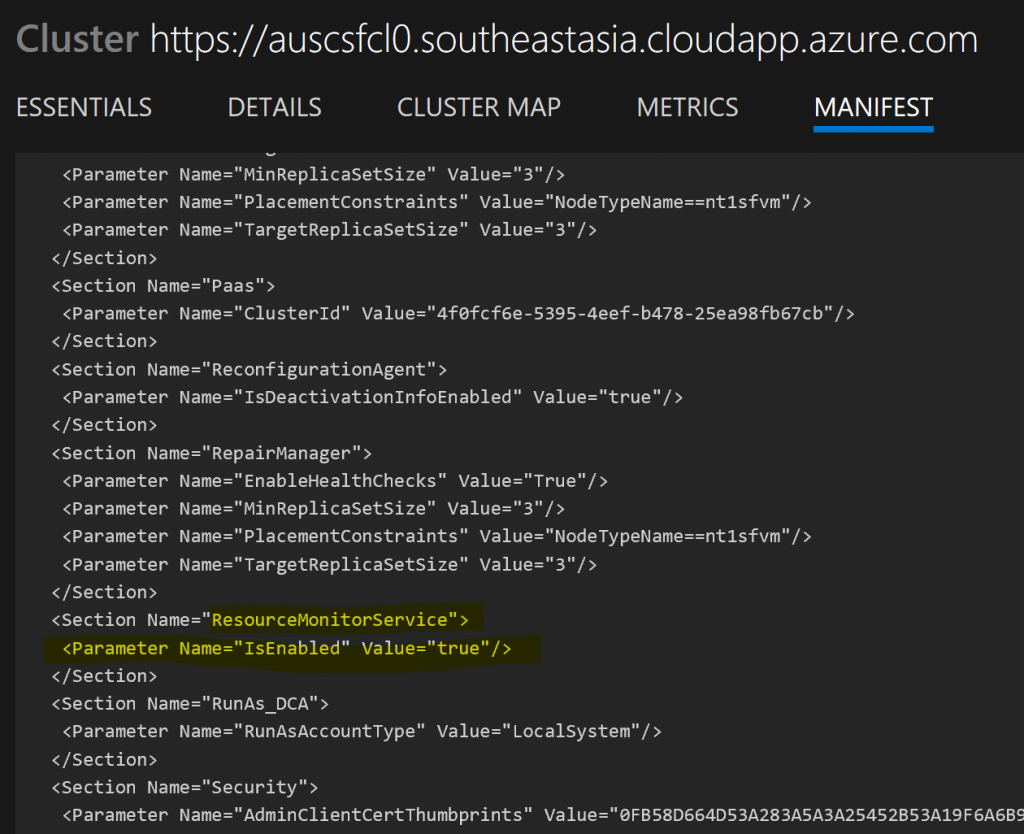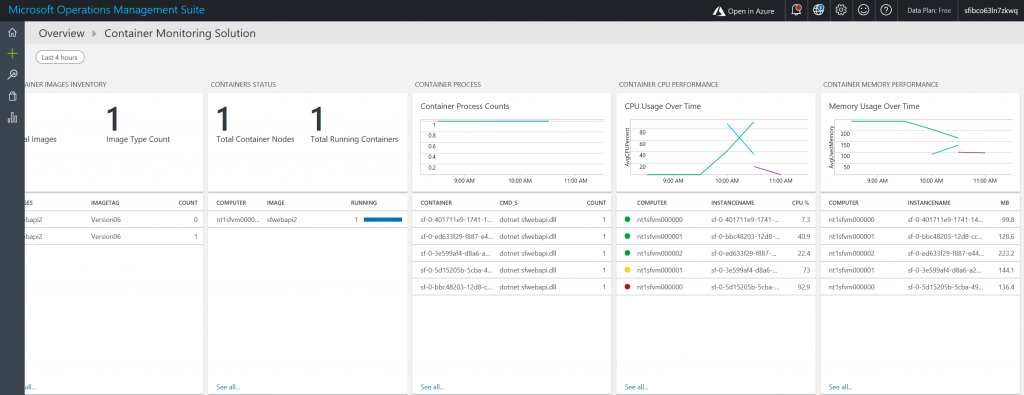Implementing Service auto scaling in Azure Service Fabric
Azure Service Fabric provides orchestration services for Applications deployed as Docker containers, along with Service level auto scaling. In this example, a Web API is built using ASP.NET Core 2.0, packaged using Docker containers for Linux and deployed to an Azure Service Cluster. A Load Test is run on the REST API to generate CPU load on the Container hosting it, thereby triggering a Service level auto scale rule. This causes additional container instances to be spun up on the other Nodes in the Custer to handle the load, and once the load dies down, these container instances are removed.
To deploy this sample in your own subscription, use the ARM template and the Service Fabric Application Packages in the GitHub Repository - here
Creating the Service Fabric Cluster
This feature requires version 6.2.194.1 + of Azure Service Fabric, and enabling the 'Resource Monitor Service' on the Cluster. Since the Azure Portal does not provide an option enable this Service at this time, an ARM Template is used that deploys a cluster with this feature enabled.
The VM Size of D1_v2 is used in this ARM Template to easily simulate the CPU load leading to an auto scale rule trigger
The ARM Template provisions an OMS Repository for Log analytics and monitoring, and to keep the Template simple, the Region used for it is the same as that of the Service Fabric Cluster itself. Ensure that OMS Service is available in the Azure region selected for the Service Fabric Cluster.
Run the ARM Template to create the Cluster. After the Service Fabric Cluster is provisioned, launch the Explorer to check the Cluster Manifest. The Resource Monitor Service would be enabled. See below
The REST API used in the sample is packaged as a Docker Container and uploaded to Docker Hub, and is referenced in the Service Manifest of the Service Fabric Application available with this article.
Deploying the sample Application to the Service Fabric Cluster
Navigate to the folder where this GitHub Repository is cloned to. The 'app-packages' folder contains the Application packages in the sample. Use Git Bash or other tools to deploy the Service Fabric Application.
Key configurations implemented in the package for auto scaling
- For auto scaling to work, the ServicePackageActivationMode needs to be set to 'ExclusiveProcess' (the default mode is 'shared')
- The auto scale trigger rule and metric name and threshold values need to be specified. Refer to this link for details.
- The instance count for the Service type is set to 1. When the auto scale kicks in, more instances of the container would be activated in the Service Fabric Cluster.
The section from Application Manifest file relevant to this configuration is shown below.
<ApplicationManifest>
<DefaultServices>
<Service Name="sfapi" ServicePackageActivationMode="ExclusiveProcess">
<StatelessService ServiceTypeName="sfapiType" InstanceCount="1">
<SingletonPartition />
<ServiceScalingPolicies>
<ScalingPolicy>
<AveragePartitionLoadScalingTrigger MetricName="servicefabric:/_CpuCores" LowerLoadThreshold="0.5" UpperLoadThreshold="0.70" ScaleIntervalInSeconds="120"/>
<InstanceCountScalingMechanism MinInstanceCount="1" MaxInstanceCount="3" ScaleIncrement="1"/>
</ScalingPolicy>
</ServiceScalingPolicies>
</StatelessService>
</Service>
</DefaultServices>
</ApplicationManifest>
The relevant config from the Service Manifest for the Application is a shown below, that refers to the Container image uploaded to Docker Hub.
<ContainerHost>
<ImageName>srikantan67/sfwebapi2:Version06</ImageName>
<Commands></Commands>
</ContainerHost>
Connect to the Cluster and install the application
sfctl cluster select --endpoint https://<yourcluster>.<region>.cloudapp.azure.com:19080 --pem opennetclcert.pem --no-verify
./install.sh
Ensure the Application is running: url in this sample - https://auscsfcl0.southeastasia.cloudapp.azure.com:5002/api/Operations
In the Service Fabric Explorer, you will observe that only one container instance of this application would be running in one of the Nodes in the Service Fabric Cluster.
Enable the OMS Agent for Linux in the VM Scale set running Service Fabric
(optional step. Required only to view the metrics in the OMS Repository)
This agent is required in the Nodes running the containerized Application, to capture the container logs and push them to the OMS Repository. These are to be activated after the application is deployed to the Cluster, since Docker has to be installed on the Nodes prior to activating this Extension. Refer to this for more details. For the OMS Solution for Service Fabric, refer to this link.
From the Azure Portal, obtain the Workspace ID and Secret of the OMS Repository and execute the CLI command below:
az vmss extension set --name OmsAgentForLinux --publisher Microsoft.EnterpriseCloud.Monitoring --resource-group <ur sf rg name> --vmss-name <ur sf vmss name> --settings "{'workspaceId':'<oms workspace id>'}" --protected-settings "{'workspaceKey':'<workspace key>'}"
This actions takes a few minutes to complete.
Run a Load Test and test the service type level auto scaling
I have used Application Insights to configure a manual load test that hits the REST API url with 1500 concurrent users, and a test duration of 15 minutes.
View the Service Fabric Explorer
Observe the Service Fabric Explorer as the test progresses. After some time, you will notice additional container instances running in the other Nodes in the cluster. After the test completes, the additional container instances would get removed from the Explorer view.
View the Container logs and Node metrics of Service Fabric as captured in OMS
Launch the OMS Workspace and launch the Container Logs and Service Fabric Solutions (these were deployed in the OMS Workspace when the ARM Template was run).
The screen shot below shows how over the course of the Load Test, additional container instances were deployed in the other Nodes in the Cluster, on trigger of the auto scaling rules. Once the Load came down on completion of the Test, the additional container instances were removed by the auto scaling rule.
Below is a screen shot from the Container log Solution in OMS, for the duration when the Load test was run.



